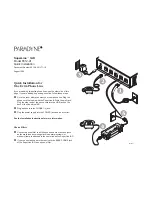
©
National Instruments Corporation
15
BNC/TC-2095 Rack-Mount Adapter Installation Guide
Figure 6.
Resistor Networks
Figure 7.
Pin 1 Location on BNC/TC-2095 for Ground-Referencing Resistor Socket
Each resistor network is labeled with descriptive numbers on the left front
side, and pin 1 is located directly beneath the darkened symbol within these
numbers. The 10
Ω
resistor network is labeled
10x-1-100
(10
×
10
0
Ω
); the
10 M
Ω
resistor network is labeled
10x-1-106
(10
×
10
6
Ω
). Figure 6 shows
examples of these resistors.
SCXI-1100 Module
For the open thermocouple channel to saturate without disturbing the
measurements on any other channel, use an interchannel delay of 200
µ
s
or greater at a gain of 100 or higher, which corresponds to a sample rate
of 5 kHz.
After installing the 10
Ω
bias resistors, you can accurately measure at the
maximum sampling rate of the module. The open thermocouple channel
may not saturate if the interchannel delay is less than 200
µ
s or if the
sample rate is more than 5 kHz at a gain of 100 or higher.
If you want fast open thermocouple detection and you have short
thermocouple leads, or if high accuracy is not important, you can replace
the pull-up resistors with a lower value resistor network. For example,
you can replace the pull-up resistor with a 1 M
Ω,
10-pin bused
configuration resistor network (not included) and have a sample rate of
20 kHz, with an interchannel delay of 50
µ
s typical.
With a 1 M
Ω
bias
resistor network, the current leakage would be 5
µ
A (5 VDC
÷
1 M
Ω
),
which can result in a larger offset error because of thermocouple lead
resistance.
Use long-nose pliers to remove or replace the resistor networks in the
sockets. Be careful not to damage the network package. Make sure that
pin 1 of each network is in the correct socket.
Mfr. code
10x-1-106
Pin 1
Mfr. code
10x-1-100
Pin 1
a. 10
Ω
Resistor Network
b. 10 M
Ω
Resistor Network
Pin 1
RP1





































